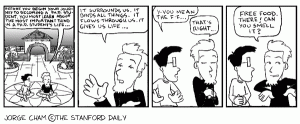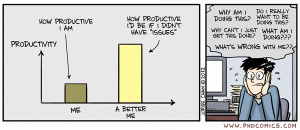On a recent episode of Living on Earth, Janet Ranganathan spoke about changes that must be made in worldwide agricultural practices in order to feed the world without destroying it. I enjoyed the interview, and was pleased to hear a conversation about world hunger that didn’t involve scaling up destructive industrial agricultural production. Her ideas sound socially and environmentally healthy. Indeed, agriculture does need to change. More than anything, though, it was a side comment that really got my attention. Agriculture, Ranganathan said, is the hungry elephant in the room. (And, based on her statistics, it’s the thirsty elephant, too. 70% of the world’s fresh water goes to agriculture). While I encourage readers to check out her work, my thoughts drifted to other elephants.
Agriculture is the hungry elephant. And while “elephants in the room” are by their nature silent, I argue that there is another, bigger, more silent one that must be addressed. Let’s call him the horny elephant. Or the Catholic elephant. What he represents is population.
Everyone saw the news: the world just passed the 7 billion people mark. Every newspaper raised the question: how will we do it? How will we feed, clothe, and house our growing population? There’s the green movement, of course: we’ll all buy environmentally friendly household cleaners for a sustainable future. Monsanto and Cargill claim to have some answers, too. But what of the problem itself? There are too many people on Earth. The crazy thing is, we would rather prepare for the inevitable 9-billion-person mark than really address the population problem. As one study from the SUNY College of Environmental Science and Forestry points out, “If we had 100 million people on Earth — or better, 10 million — no others would be a problem.”
It’s not hard to find advocates for lowering the birth rate in Bangladesh and Nigeria. Educate women, provide access to birth control, whatever it takes. An compelling article in the New York Times titled “Talking Their Way Out of a Population Crisis” addressed one possibility for population control: dialogue. Apparently, just “relaxed, trusting and frank conversations between men and women may be the most effective contraceptive of all.” What a cheap solution!
The United States and Europe already went through one demographic transition around the turn of the 20th century, when birthrates dropped significantly. By many standards, our birthrates are low. Children born in the West, though, will consume far more than children from developing nations in their lifetimes: as for carbon, an American generates 66 times more CO2 each year than the average Bangladeshi, with an overall lifetime carbon footprint 160 times greater (see OSU pdf below).
I think it’s time to turn the conversation around and discuss our own horny elephant right here in the U.S. The choice about how many children to have is one of the biggest decisions one makes—and not just for the immediate family. Blogger Lisa Hymas points out that all of the “green” choices we make—driving a hybrid, changing our lightbulbs, taking short showers— “don’t come close to the impact of not bringing new human beings—particularly new Americans—into the world.” A 2008 study (see pdf here) from Oregon State University reiterates this message, looking at how the reproductive choices of an individual contribute to his environmental impact. Ultimately, it says, “A person’s reproductive choices must be considered along with his day-to-day activities when assessing his ultimate impact on the global environment.”
It’s not just about climate, either. In an interview with the authors from OSU, one said, “Rapid population growth affects other species (think ivory-billed woodpecker, passenger pigeon, blue whale and Fender’s blue butterfly) and exhausts the planet’s carrying capacity. At current levels of production, it has been estimated that it would take 1.4 Earths to maintain today’s population into the future. In other words,” he concludes, “we’re living off the capital now.”
Population control, then, is not just an issue for those overpopulated developing nations. As global citizens, I think we should recognize that population does need to be addressed. We are part of the problem, and should be part of the solution, too. I don’t mean that we should all shun childbirth. You (or I) could decide to have a couple of kids, or no kids at all. Or maybe, in light of this global problem, have one less child than we otherwise would have.
I know that population growth and control is a complex issue. Any population control needs to be sensitive to the rights of women, and am no way am I suggesting a return to the forced sterilizations of women in the U.S. and abroad. And yes, if population growth slows, we will have to face an aging population. Social Security will suffer. What will we do with all those old people? I hear this argument a lot. If we have less children, we’ll face a crisis. What I don’t hear is that we’ll face a crisis either way. Either we make some tough adjustments for a generation or two while our growth slows, or we make tougher adjustments because our growth didn’t slow. Recent political events (or, non-events, since nothing has really happened) have underscored the reality that, as a nation, we’re a bunch of procrastinators. We’ll deal with it later, because we don’t want to make tough choices now.
If you want to have kids, great (seriously). I can be a fan of kids. But I think we should pause and think about the bigger picture—reproduction isn’t just a right. It’s a choice that affects everyone, a choice that carries great responsibility. So let’s talk about it. Just like we want those Africans to do, lets talk about our family choices. In that conversation, let’s recognize that there are lots of ways to lead a fulfilling life. Some involve parenting, and some don’t. I can’t implore others to think about this issue without doing it myself. I might have a kid. I might not. That decision is important, not just for me, but for everyone.



